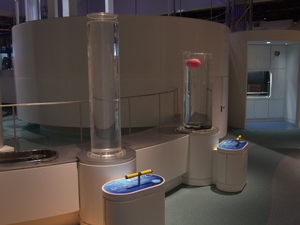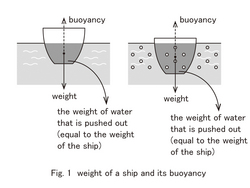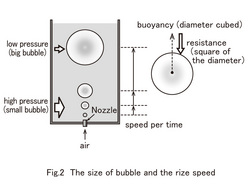Nagoya City Science Museum
TOP > Exhibition Guide > Keyword Search > Starting with "B" > Bermuda > Bubbles in the Water
Bubbles in the Water

Purpose of Exhibition
Water on the ground evaporates and turns into vapor. It soars upwards and makes clouds in the sky. Over time clouds are transformed into rain (water), which returns to the ground and pours into the ocean. Water circulates on the earth. In this "Exploring Water" exhibition, you can deepen your knowledge about this big circulation and characteristics of water through various experiments.
We will explain two exhibits in this "Oceanic Stage". Find out about the characteristic of bubbles.


Additional Knowledge
[Mystery in the Bermuda Sea Area]
A ball is floating in a cylinder-shaped water tank. Operating a lever makes a large amount of bubbles. Then, the floating ball begins to sink gradually. What made it occur?The reason a heavy ship floats on seawater is because an upward force or buoyancy works against the ship. The magnitude of buoyancy is equal to the weight of the seawater that a ship gets rid of. A ship floats on the sea when a ship's weight and its buoyancy are balanced (Figure 1).
Suppose that a large amount of bubbles, that is, air, is contained in seawater, so the apparent amount of seawater that a ship eliminates has to be increased. That is, unless a ship is sunken deep, you cannot provide the apparent amount of seawater (Figure 2).
It has been said that ships often sink in the Bermuda sea area near the Florida Peninsula in the United States. There is a scholar who points out the following phenomenon as one of the reasons. His theory is that there is a large amount of methane hydrate in the sea bed around this area. Due to the bubbling methane rising from the sea, ships tend to sink around that area. Methane hydrate is methane, which is a gas at standard temperature and pressure, in a similar state as sherbet at the bottom of the sea.
[Speed of Rising Bubble]
This is an experimental device that sends air to the bottom of a water tank, and makes bubbles. With this device, rising bubbles are observed.
Note that bubbles are small at the beginning, but grow bigger gradually, and rising speed increases as they develop larger.
At first, the change in size will be explained. Bubbles are air and also gas. When pressured, they grow small. When pressure is lowered, they make a big change in volume. This is Boyle's law. The bottom of a water tank is a place where fluid pressure is applied most. At this point, a bubble is small. However, since fluid pressure becomes smaller as a bubble rises, bubbles grow big (Figure 3).
Next, think of the upward acting force that applies to big bubbles. Buoyancy is applied on the bubbles. Since the magnitude of buoyancy is the same as the weight of discharged water, it is proportional to the volume of the bubbles. Suppose that a bubble is a ball, it is proportional to the cube of the diameter. That is, the bigger the diameter of a bubble grows, the more rapidly buoyancy increases.
On the other hand, while bubbles are rising, water resistance is applied to them. The force that pushes down bubbles to rise, or in other words, a downward acting force works on it. This force is proportional to the cross-section area of the bubbles. Although the bigger the bubble, the greater the downward force, it is slower than that of buoyancy.
Comparing the upward acting force, buoyancy with the downward acting force, resistance, it is understood that bubbles, which grow bigger as they float up, also speed up as they rise (figure 4).
Article by Koichi Mabuchi, curator
